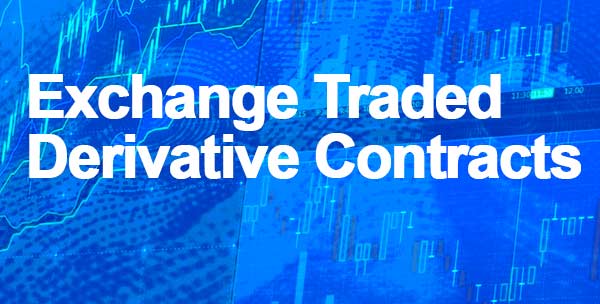
Standardized derivative contracts are exchange-traded when they are exchanged on a formal futures exchange. They need to be paid with a down payment or margin that is cleared by a clearing house. The exchanges have devised a uniform naming scheme to make it clear which derivative is being exchanged.
A financial contract that is listed and traded on a regulated exchange is an exchange-traded derivative. Derivatives can be used to speculate on a variety of financial assets as well as to hedge exposure. Two of the most widely used exchange-traded derivatives are futures and options. On regulated exchanges like the Chicago Mercantile Exchange or the Intercontinental Exchange, derivatives are listed and traded. Unlike their over-the-counter relatives, some retail investors may find them to be a good fit.
Each derivative contract on the market has standardized terms and parameters. This makes it simpler for investors to ascertain key details about the securities they are trading. For any transaction involving an exchange-traded derivative, the exchange serves as the counterparty. It basically makes every seller a buyer and every buyer a seller. For instance, instead of ordinary options, a trader would prefer mini options (10 shares) on expensive equities (100 shares). Clients must promptly supply the necessary capital if they suffer losses that reduce the initial margin amount below a specific threshold, or the firm may close their transaction.
Exchange-traded derivatives are used to hedge portfolio values and make predictions about price changes. To fix exchange rates for upcoming transactions, an import-export company may employ currency futures. Banks may use the opposite position in Treasury Futures to hedge their holdings of US Treasuries. The majority of investors are comforted by the standardization and regulatory oversight provided by centralized exchanges. Retail investors could purchase stock options to safeguard the value of their stock investments. Alternatively, they might just be interested in the premium income generated by the sale of an option contract at a particular price. Institutional investors have the option of working directly with issuers and investment banks to create investments that are tailored to their requirements and offer the precise risk and reward profile they require.

Exchange-traded Derivative Contracts are standardized contracts having a fixed expiration date, consistent trading volume, and simple offsetting. By giving traders the flexibility to offset past contracts, Exchange-traded Derivative Contracts offer a great deal of convenience. They must abide by the guidelines established by the regulatory body and stock market. Exchange Traded Derivatives don't have direct counterparty risk like OTC derivatives do. This is so because the stock exchange serves as a formal middleman and binds the trading parties to contracts. The market regulators' rules and regulations apply to exchange-traded markets.
Due to its tremendous liquidity, the exchange-traded derivatives market has a significant amount of market depth. Stock derivatives are only traded on the National Stock Exchange and Bombay Stock Exchange. Exchange-traded Derivative Contracts are based on the stock market segment, where equities are used as the underlying asset for the exchange-traded Derivative Contracts. Traders can take heavily leveraged positions on stock price movements using both varieties of stock derivatives.
The performance of significant stock indices is tracked through index Exchange-traded Derivative Contracts, a type of derivative product. The weighted average of the 50 biggest businesses listed on the Indian stock exchange is known as the 'Nifty 50.' The S&P 500 is an American stock market index that tracks the stock performance of 500 well-known corporations.
You can trade in many currencies at once using exchange-traded products (ETDs). The following pairs of currency-related Exchange-traded Derivative Contracts, for instance, are available for trading on the NSE. Indian Rupees against US Dollars (INR-USD).
Futures contracts for commodities are traded based on changes in commodity prices. At the Multi Commodity Exchange of India Ltd., you can trade commodities futures in India (MCX). Gold, crude oil, silver, natural gas, copper, zinc, and other commodities are only a few instances of standardized contracts on commodities.
You can trade in bonds using bond Exchange-traded Derivative Contracts as the underlying asset. The NSE is the exclusive marketplace for trading bond derivative products. Choose a brokerage company that offers a variety of advantages, such as a free Demat account and trading account, an all-in-one trading platform, etc.
Clearinghouses will take care of the technical clearance and settlement responsibilities required to conclude deals. Clearinghouses are highly regulated organizations that manage credit risk between two trading parties. Most transactions involve a central clearing counterparty (CPP), which controls credit risk for both parties.
Exchange-traded derivatives feature transparent prices and standardized contracts, making it simple to buy and sell them. Investors can locate buyers or opponents to sell to more easily when there is high liquidity. Transactions can be performed in a way that minimizes value loss because more investors are active at the same time.
Exchange-traded derivatives are advantageous because they keep the two parties to a transaction from dealing with one another through a middleman. No party in a transaction will be exposed to counterparty risk because both parties will report to the exchange. The exchange will serve as a middleman and take on their client's financial risk.
Standardized contracts for exchange-traded derivatives are unchangeable, which limits the market's ability to respond. Since the contracts already explain the characteristics of the instruments in great detail, there is no need for negotiation. The rigorous control of the exchange is supposed to make it safer. The exchange also makes statistics available on all big daily trades. It so successfully prohibits the few significant participants from taking advantage of the market.
It is possible to make a contract without intending to complete the underlying goods transaction. In this situation, it's possible that neither the vendor nor the buyer intends to accept the delivery of the items. For calculating and paying contract gains and losses, a clearing technique is necessary. The first bulk commodities traded were herring, whale oil, and wheat; these products need unique handling and storage facilities.